Benin is a tiny West African country that truly surprised us. After the gruffness of Cameroon and Equatorial Guinea, finding such a warm and welcoming place was a delight!
This is a country steeped in rich history and a vibrant culture. It beckons travelers with its captivating blend of ancient traditions, natural wonders, and unexplored adventures. As the birthplace of Voodoo, a spiritual practice that reveres natural spirits and ancestors, Benin unveils a fascinating tapestry of beliefs and practices that have shaped its cultural identity.
Unfortunately, Benin’s history is also intertwined with the tragic era of the transatlantic slave trade, a period that left an indelible mark on the country’s social fabric. And yet, the Beninoise are still positive, genuine and welcoming.
Read on to find our 5 rmagic reasons to visit this lovely little country!
Logistics
Guide/Driver

We were very fortunate to find a guide/driver through recommendations from other fellow travelers. The organization that we used is called: Green Paths Travel and the owner’s name is Isaac Aziawo. Guide/driver was Eli. Email: [email protected] What’s App: +228 98 22 58 68
Currency
Benin uses the West African CFA Franc (XOF). This currency is shared by eight West-African nations: Benin, Burkina Faso, Ivory Coast, Guinea-Bissau, Mali, Niger, Senegal, and Togo. The XOF is quite stable as it is now pegged to the Euro.
Sim Cards
When it comes to connectivity, there are a few SIM card options in this country: MTN and Moov. We got the MTN option in the airport – all in (for the card) and a few GBs of data it was around $6 USD for a week (purchased in the airport). We were told that the plan would not work in neighboring Togo (which it did not).
Airport Pickup
Try to pre-arrange your airport pickup in advance. Our hotel (which we cannot recommend) sent a lovely man to pick us up. Once we exited the airport we were swarmed by taxi drivers. Some even followed us to our pickup van and demanded to see our drivers identification (even through the van had the name of the hotel on it).
Top 5 Things to See and Do
1. Ganvie: Unveiling the African Venice

Amidst the tranquil waters of Lake Nokoue lies Benin’s Ganvie, affectionately dubbed the “Venice of Africa,” a testament to human ingenuity and resilience. This ancient stilt village, brimming with life and steeped in rich cultural heritage, is a must-visit destination for any traveler seeking an immersive African experience. Ganvie is also the largest floating village in Africa. In addition, it was recognized as a world cultural heritage site by UNESCO in 1996.
This village’s origins trace back to a dark chapter in African history, the era of the transatlantic slave trade. The Fon warriors, notorious slave hunters, threatened the peaceful existence of the Tofinu people. Seeking refuge from the horrors of capture and enslavement, the Tofinu devised an ingenious solution: they built their homes atop the shallow waters and islands of Lake Nokoue, transforming an isolated body of water into a haven of safety and freedom.
Today, Ganvie boasts a population of around 20,000, with fishing and tourism serving as their primary sources of income. The village’s unique architecture, characterized by wooden stilt houses interconnected by a network of canals, has earned it international acclaim, attracting visitors from around the globe.
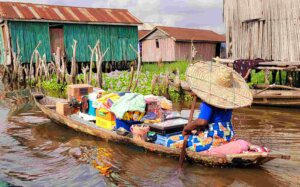
A day trip here, just 9 kilometers from Cotonou, invites travelers to delve into the heart of the Tofinu culture. After a short car ride we were taken by pirogue (a local wooden boat) along the water channels of the lake. Gliding along, we marveled at the vibrant colors and carvings that adorn the stilt houses. Engaging with the locals, whose warm hospitality and infectious smiles radiate throughout the village was definitely a highlight of our trip here and the country overall.
Lake Nokoue, spans an impressive 16,000 hectares. In addition to the stilt homes, it also serves as a sanctuary for a diverse array of birdlife. Birdwatchers delight in spotting the African openbill, with its distinctive curved beak, and the elegant white-crested heron, gracing the lake’s serene waters. This areas tranquil ambiance and abundance of birdlife make it a paradise for nature lovers and history buffs alike.
PRO TIP: Pre-arrange your trip on the pirogue with your guide/driver as prices may vary once you are at the dock. Eli pre-arranged everything and made the experience very smooth.
2. Marche Dantokpa – Cotonou

As you may already know, we travel to a lot of markets around the world. Some are dirty and smelly. However, the Grande Marche in Cotonou (Marche Dantokpa) is one of the most vibrant and colorful markets that we have ever visited. It is also the biggest open air market in all of West Africa. The Grande Marche is a pulsating hub of commerce and culture that serves as the city’s beating heart. Stretching along the banks of the lagoon and Boulevard St Michel, this labyrinthine marketplace overflows with an endless array of goods, catering to most needs and desires.
From the colorful stalls of fruits and vegetables (my favorite) to the bustling fishmongers section (which I tried to avoid), where the catches of the day are traded with lively banter, to the overflowing stalls brimming with soap, plastic sandals, and pirated DVDs, the Grand Marché du Dantokpa is a sensory overload. The aroma of spices mingles with the sounds of haggling and the rhythmic pounding of traditional drumming, creating an atmosphere that is both chaotic and captivating.
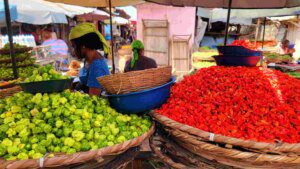
Venture deeper into the market’s labyrinthine alleyways, and you’ll discover a treasure trove of traditional African textiles, including vibrant batiks and colorful Dutch wax cloth. The market building, a grand structure that stands as a testament to Cotonou’s colonial past, houses a curated selection of handicrafts and souvenirs, perfect for those seeking authentic mementos of their Benin adventure.
For those with a penchant for the unusual, the fetish market section at the northern end of the Grand Marché du Dantokpa offers a glimpse into the spiritual beliefs and practices of the region. Here, you’ll find an array of amulets, talismans, and other ritualistic objects, each imbued with a unique power and meaning.
Navigating the Grand Marché du Dantokpa is an adventure in itself. Be prepared to bargain, and engage with the friendly and spirited vendors who bring this bustling marketplace to life. As you wander through the maze of stalls, let your senses guide you, and you’re sure to uncover hidden gems and experience the true essence of this cities’ vibrant culture.
PRO TIP: Make sure to keep all of your valuables hidden well away. Our driver followed behind us and got into some heated arguments with folks who allegedly were trying to get into my backpack (which I had collapsed under my arm and tried to keep as closed to my body as possible). And still they tried to get into it.
3. Ouidah – Slave Trade
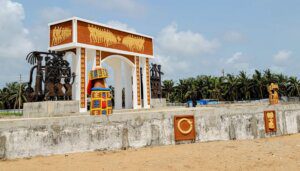
Ouidah is a town on the coast of Benin. It stands as a captivating blend of ancient history, vibrant culture, and spiritual intrigue. Once a thriving port city during the transatlantic slave trade, Ouidah’s legacy is intertwined with tales of resilience and cultural preservation. Today, it beckons travelers with its UNESCO World Heritage Site status, its rich Voodoo heritage, as well as its wide and abandoned beaches.
Sadly, Ouidah played a pivotal role in the transatlantic slave trade. Once a bustling port city, it’s dark history is intertwined with the suffering of countless Africans who were forced into slavery.
Nicknamed the “Slave Coast” by Europeans, the Bight of Benin region, where Ouidah is located, served as a major source of enslaved labor for the Americas. Over a span of two centuries, this town alone exported over one million Africans, making it one of the largest slave trade ports in all of Africa. Only Luanda in Angola, a port in Central Africa, surpassed Ouidah in the volume of enslaved people transported.
The echoes of this tragic chapter in history still resonate in the city today. It’s historical landmarks, such as the Door of No Return, serve as poignant reminders of the resilience and suffering of the enslaved Africans who passed through its gates.
As you explore this town, pay your respects to those who were taken from their homeland and acknowledge the profound impact of the slave trade on the city’s history and identity. Let Ouidah’s past serve as a reminder of the importance of human dignity and the fight against all forms of injustice.
4. Ouidah – Voodoo

Ouidah also has a deep-rooted connection to Voodoo. This ancient spiritual practice has shaped the city’s identity and traditions.
The Temple des Pythons is one of the top tourist attractions in the city. It is a sanctuary dedicated to Dan, the serpent deity revered in Voodoo. Some people really enjoy this kind of stop. I personally dislike interacting with snakes, so was not as excited about the opportunity as Rob was. The temple has dozens of pythons that are deemed sacred and harmless. You are encouraged to interact with them, as Rob did do.
Each year on January10th, Ouidah comes alive during the vibrant Voodoo Festival, a captivating spectacle that draws devotees and visitors from around the globe. If this is something that interests you, you can immerse yourself in the rhythmic beats of traditional drums, witness elaborate processions, and witness the trance-like states of the possessed, known as hounsi during this festival.
In addition, one can wander through the bustling fetish markets of this town. There you can discover an array of amulets, talismans, and ritualistic objects, each professed to be imbued with a unique power and meaning.
One can also engage with local Voodoo practitioners to gain insights into the symbolism and significance of these objects. Voodoo priests and priestesses who serve as guardians of spiritual knowledge are also available to engage with to gain a greater understanding of this ancient practice.
5. Porto Novo – the Capital of Benin
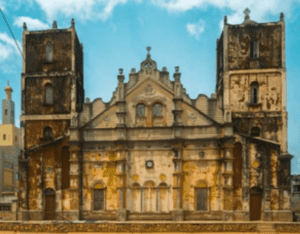
Porto Novo is actually the country’s capital. This city is often overlooked in favor of its more bustling neighbor, Cotonou. However Porto Novo offers a tranquil retreat, where visitors can delve into the city’s rich history, explore its architectural gems, and immerse yourself in the rhythms of local life.
This city’s historical significance is evident in its well-preserved colonial architecture and landmarks. One can stroll along the picturesque streets lined with colorful buildings, each bearing witness to the city’s past as a major trading hub. The Brazilian influence within the city is clear thanks to the colors and organization of the buildings along the major streets.
Top places to visit in Porto Novo are the Jardin Place Jean Bayol, Musee Honme (Palais Royal) and the Great Mosque.
Wrap-Up
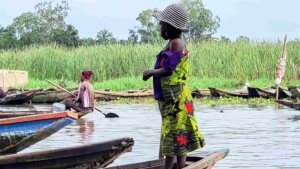
Benin really surprised us. It is a land steeped in rich tradition and history. It is the birthplace of Voodoo, a spiritual practice that honors natural spirits and venerates ancestors. The country’s history is also intertwined with the tragic transatlantic slave trade – a somber chapter that is preserved in its museums and especially in Ouidah.
This country felt safe, vibrant and colorful. We fell in love with Ganvie and Ouidah and it’s resilient and friendly people.
Have you been to West Africa, or more specifically Benin? Are you planning to go? We would love to hear from you in the comments.

